The first Monument of the year, this Saturday’s Milan-Sanremo is all about the tense finish, the paradox of the longest race of the year that’s often decided in the final metres and one of the rare one day races where grand tour contenders and sprinters can each stake their claim. Who will keep their nerve?
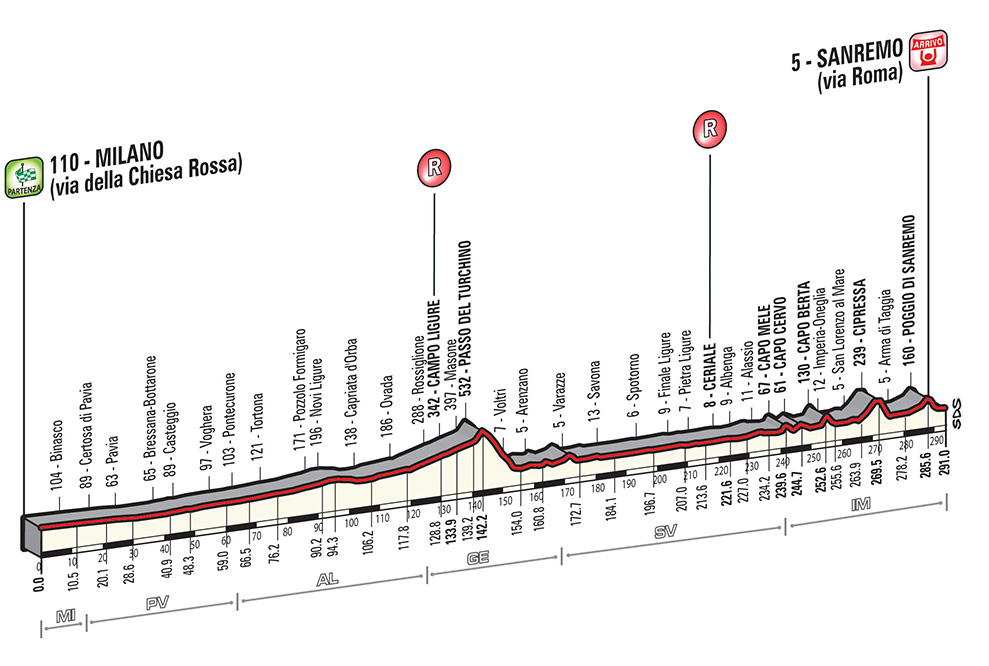
The Route: 291km plus the processional ride out of Milan. Once the official start is done the race traverses across the vast Po valley and the Pianura Padana, the featureless plains that grow much of Italy’s rice crop, for 100km. Ovada is the town that marks the start of the long Passo del Turchino. This climb used to be important to the race but it’s a slow and gradual climb and the road is tracked by a railway line, a clue to the gentle gradient. Turchino means a shade of blue in Italian, hinting at the Mediterranean sea that awaits on the other side. The pass is a symbolic moment of passage, lifting riders away from the wintery plains to the shimmering spectacle of the Mediterranean with its palm trees and blooming flowers, from winter to spring via one mountain pass.
It’s a steep and stressful descent with tunnels to the outskirts of Genova. The halfway point is crossed but the finish feels closer, the coastal road familiar. The race goes from one town to another, negotiating modern street furniture and antiquated town squares alike. In time comes the cape trinity: Capo Mele, Capo Cervo and Capo Berta. These are small climbs but serve as landmarks to break up the flat road and by now the race has done 250km.
Then it’s on to the Cipressa (full detail here). This starts with sharp right hander and quickly climbs through olive groves above the coastal town of San Lorenzo, the 9% gradient bites hard after 270km. This is a proper moment of climbing that can prove fatal for the sprinters, the average of 4% is a blend of a steep start and a flat portion over the top where dropped riders flounder. Television cameras often follow the back of the peloton to catalogue the dropped riders because the toboggan-run descent, the most technical part of the entire course, is often too fast to film in full. The race continues along the coastal road, the Via Aurelia.
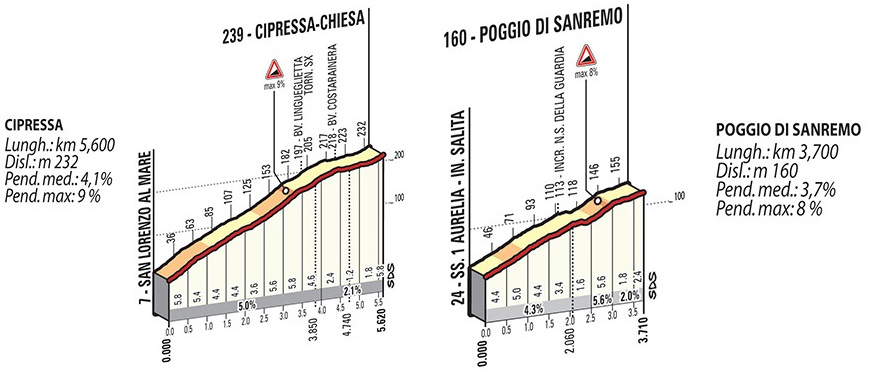
The Finish: the Poggio (more here) starts with 9.2km to go and marks the final phase of the race. A furious pace is inevitable. A right flick off the main coastal road is followed by series of wide bends that are so fast some riders have to brake before entry despite going uphill. Positioning is everything as the road winds up, every metre matters. Unlike the Cipressa this isn’t steep, there’s only one short step at 8%. But after 285km the elastic is like an aged rubber band and the Poggio is just enough snap the peloton.
The descent is fast and marked by a series of curves and five hairpins. The race has been won on the descent before and it has its technical moments, for example knowing which bend has the sunken inspection cover on the exit line helps but this is not for virtuoso descenders, instead it suits those with power, a series of sprints out of every corner. Carrying speed into the bends matters but what matters more is being able to pump out big watts on every exit. The ramp ends with fast junction onto the main road and it’s left at the fountain, then right on the Via Roma which has the slightest of slopes up to the finish line.

The Scenario: a bunch sprint? If only it was so simple. The chart above shows the size of the front group in Sanremo over the years. All the blue bars represent the years with the Cipressa-Poggio combo and the grey ones represent the harder years with the additional climb of Le Mànie, now skipped. It shows any “bunch” sprint is really a reduced group, typically the Poggio reduces the race to 20-40 riders. With seven hours in the legs the resulting sprint is a test of force and energy rather than pure speed and few have a team mate left to lead them out.
We’ll see an early move go clear. Look to see which teams place riders in it and if there are any big engines in the move to keep it clear for as long as possible. As ever the pace ratchets up along the coastal road, on TV you might see a bunch of riders, the trick is to spot which teams still have plenty of riders and who is well placed.
Onto the Cipressa and long range moves are hard, nobody has attacked and stayed away since 1996. It’s still strategic, a chance for teams to play some cards and the harder the pace, the more the sprinters will struggle. It’s got some steep sections and it’s easy to crack and then lose 30 seconds over the flat section to the village of Cipressa: game over. There’s always a danger moment on the flat coastal approach to the Poggio as a move can slip away while others get into position, everyone wants someone else to chase. The Poggio’s early slopes can look slow on TV but chances are the bunch is going full gas only space is at a premium and the riders are packed like sardines. The best attacks came late on the steepest part after the chapel on the left and a breakaway only needs 10 seconds over the top to stay away.
The Contenders
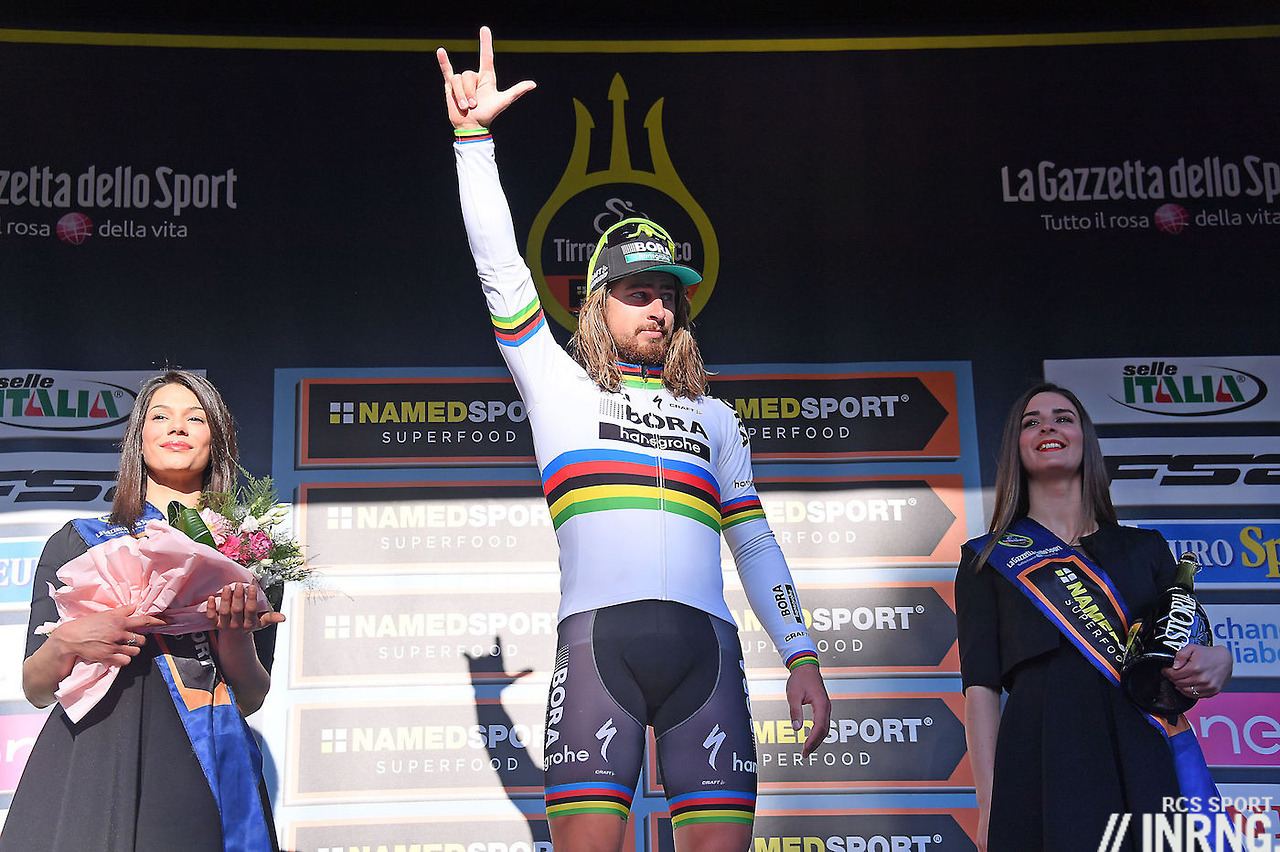
Peter Sagan looks invincible right now, at ease on the climbs and winning bunch sprints. He’s been in contention several times here but has yet to win in Sanremo. He seems more relaxed, he’s shown he’s willing to lose races which will help reduce the queue of riders on his wheel. Still he’s the celebrity pick, an obvious choice but if it comes down to a sprint he’s got plenty of competition and if he could design the course he’d surely make it more selective. As ever his Bora-Hansgrohe team are not going to impose themselves on the race but Sam Bennett could feature, he copes well with a climb or two and as we saw in Paris-Nice he can beat the best on his day.

Fernando Gaviria is Sagan’s nemesis. The Colombian crashed within sight of the finish line last year and as bad as this was, it proved the neo-pro could handle a 300km race and reach Sanremo. Now we’ll see if he’s still got the zip in his legs, he’s an ex-track rider but this is a stamina sprint rather than speed contest. To make things harder he’s sustained a wrist injury after crashing on Thursday. This could be ruinous in a long race, especially when required to pull on the bars in the sprint. But so far the extent of his injuries is unknown, just pictures of him with a taped wrist so we don’t know if his wrist is duff… or bluff? Still he’ll lose a chainring for the ratings below for this. He leads a Quick Step team with more back-ups than Team Sky’s computers. Tom Boonen can sprint and add an extra line to his palmarès, the same for Paris-Tours winner Matteo Trentin although both are likely to lead out Gaviria. Julian Alaphilippe was drafted in late and is a good pick for Poggio attack and he’s perfect for the descent too, fearless and able to punch out of each bend and there’s Philippe Gilbert too for the very same role.
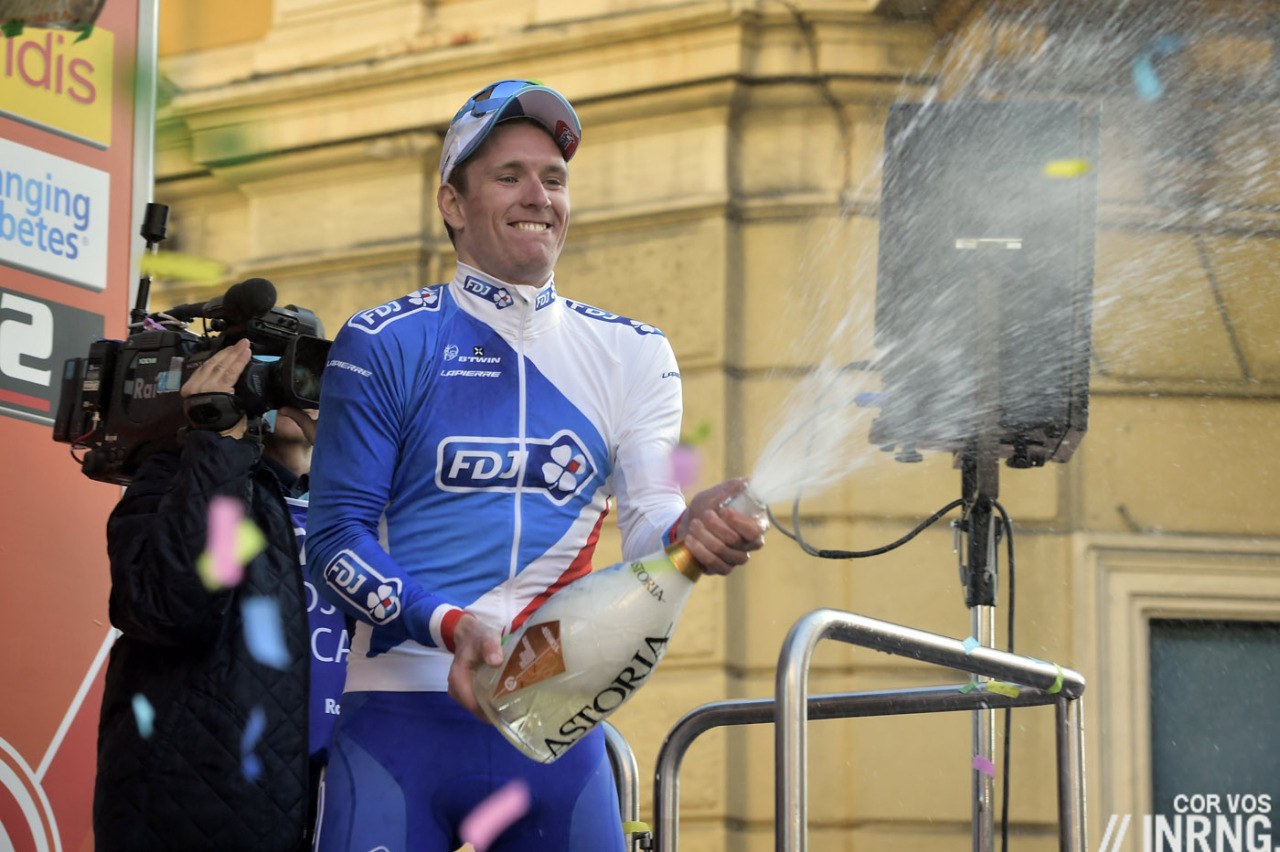
Arnaud Démare won last year and has an excellent long sprint for a finish like this. As we saw in Paris-Nice he was the only rider to match Alaphilippe uphill on the opening stage so he’s in good form and has an FDJ team built around including the valuable additions of Davide Cimolai and Jacopo Guarnieri.

Michael Matthews was the five chainring pick a year ago and he remains a prototype contender because he can float over the climbs and has an excellent sprint. He seems to win big too, his palmarès is all quality. Sanremo is his big early season target and has been for the last couple of years. But how does he plot his path to the win? He can sprint but so many many others so does he try a move on the Poggio because he can climb better than other sprinters but what if the likes of Sagan arrive with him?

Alexander Kristoff doesn’t have to worry about tactical scenarios, he’ll surely settle for a sprint and nothing else. After all he won this way in 2014. He has the stamina for the sprint but hasn’t looked too sharp of late with a discreet ride in Paris-Nice but has been quiet before but made the podium in 2015 and was sixth last year too meaning Katusha’s captain knows just what it takes.
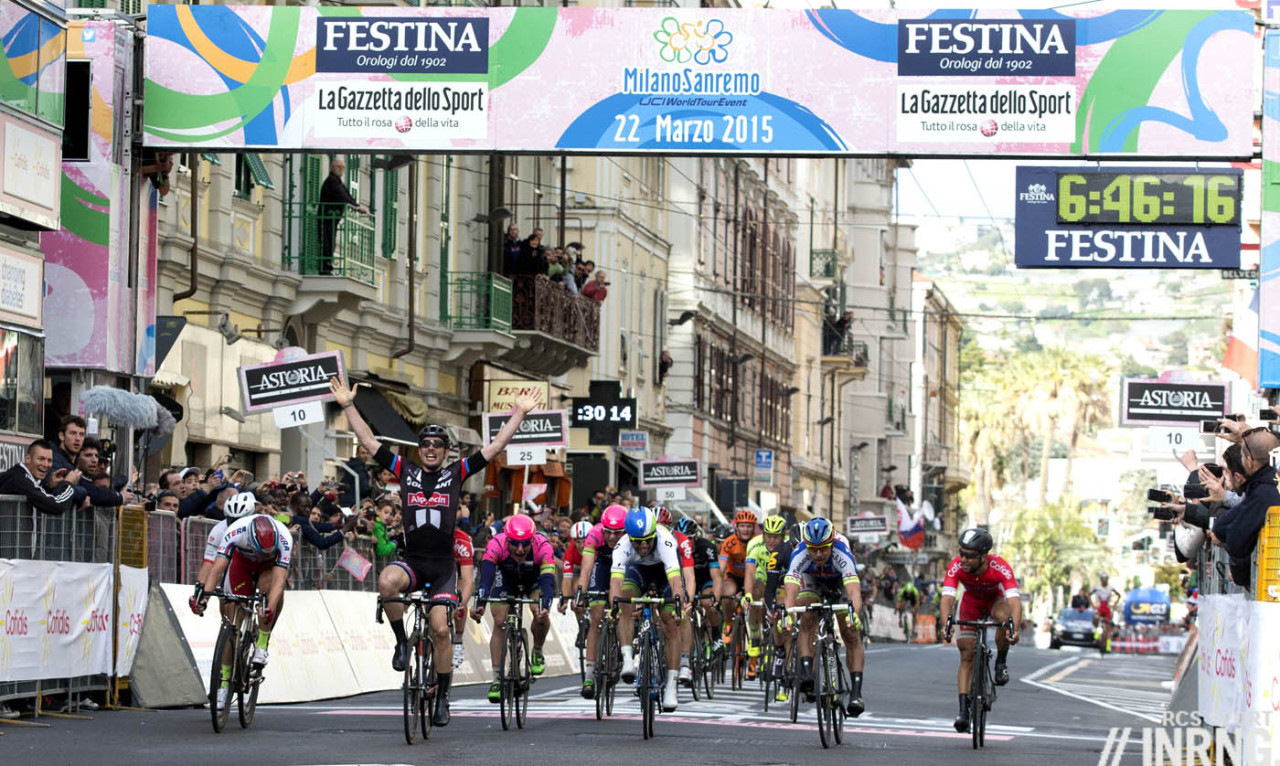
John Degenkolb is another previous winner and also had a quiet Paris-Nice but seemed to be using the week for training. He leads the Trek-Segafredo who can play other cards such as Fabio Felline who can cover uphill attacks and sprints well from a small group and Jasper Stuyven makes a precious lead out also has the power to barge away down the Poggio or even in the streets of Sanremo.
Nacer Bouhanni‘s odds must have fallen this week after the Nokere Koerse, finally a win and a convincing one too. He’s been close before and arguably would have made the podium last year were it not for an involuntary gear shift. Sanremo’s been his big goal all along with plenty of endurance training to prepare for this.
Mark Cavendish is another previous winner but has looked quiet. He’s done this before of course, famously faking it during Tirreno-Adriatico before winning Sanremo in order to stay under the radar. In other times he’s looked quiet before and got dropped on the climbs too so he’s far from a certain pick but if he’s in contention as they come into Sanremo all eyes will be on him and his ability to slalom through the group. Dimension Data also have Edvald Boasson Hagen who has seemed made for this race only he’s never been a threat. Steve Cummings is there too and will look to pounce the moment the bunch hesitates, be it on the Cipressa, Poggio or the streets of Sanremo.
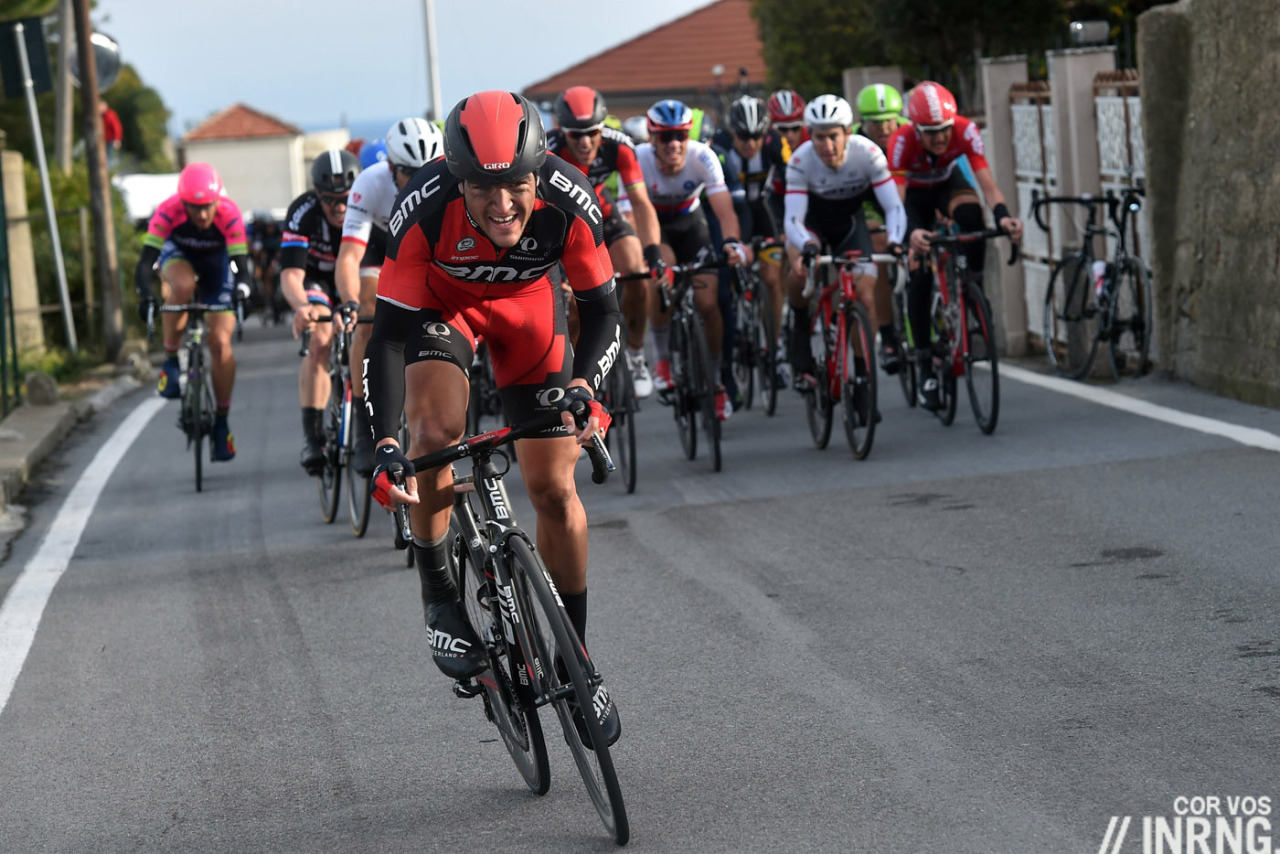
BMC Racing’s Greg Van Avermaet is almost under the radar as a contender. He’s winning so much these days but how does he win in Sanremo? A sprint finish won’t work so he has to go on the attack and this is so obvious there will be a queue on his wheel as they scale the Poggio.
Caleb Ewan leads Orica-Scott but if he’s a sprinter has he got what it takes for Sanremo where high speed and aerodynamics helps but the final dash to the line is a test of what’s left in the tank. That tank could be rickety given he had to abandon Tirreno-Adriatico. On paper the team promise plenty with previous winner Simon Gerrans and the enduring ability of Michael Albasini while Magnus Cort Nielsen is a classy rider who can fill the void left by Michael Matthews and Jens Keukeleire as another sprint card.
Sonny Colbrelli‘s stage win in Paris-Nice was a step up and he’s placed in the top 10 in Sanremo before but a win and even a podium would be a big improvement; Bahrain-Merida team mates Niccolò Bonifazio is an outsider for the sprint too while Giovanni Visconti is likely to try an attack along the way as he did last year.
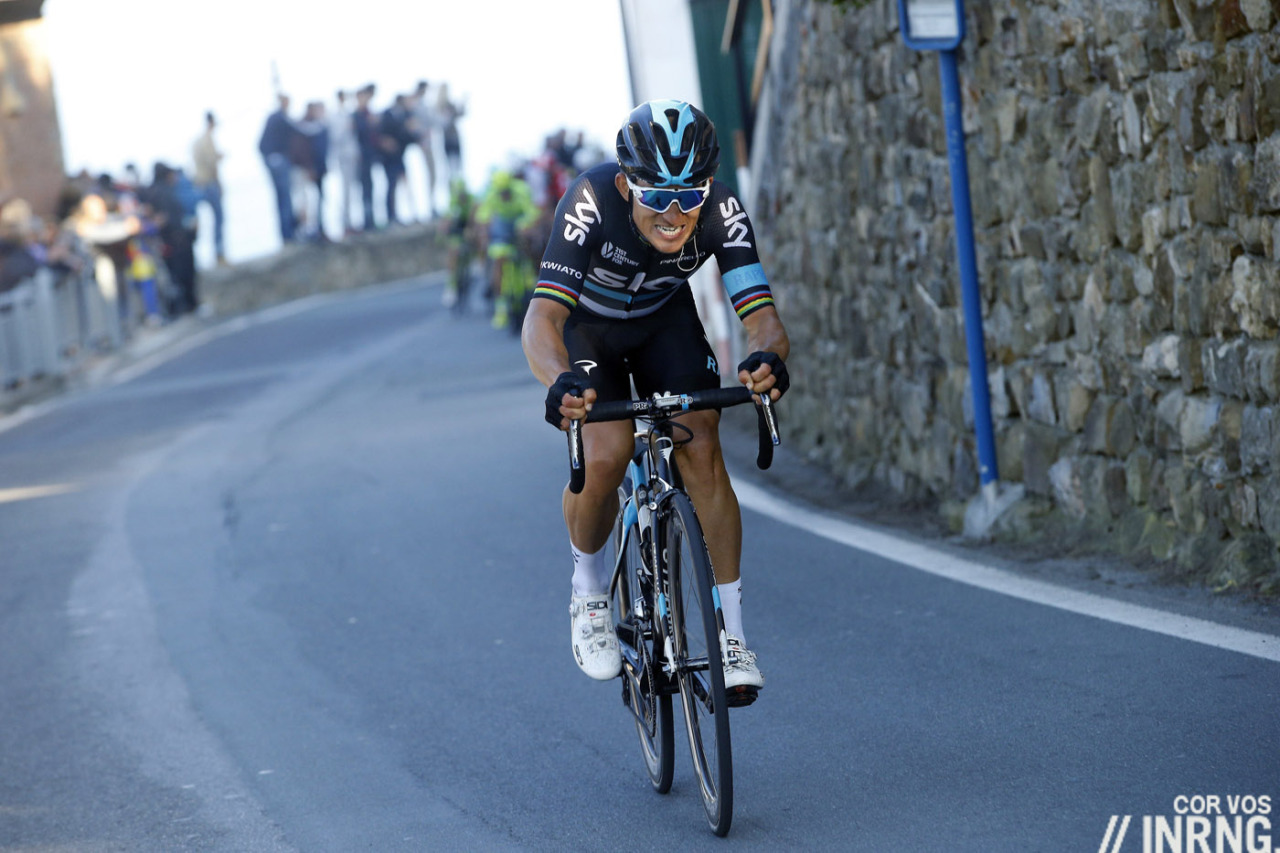
Team Sky line up behind their sprinter Elia Viviani who has made Sanremo his big objective so the team will be looking to apply what they learned from Cavendish to him. Meanwhile Michał Kwiatkowski would be a fitting winner in the “city of flowers” and has the punch and descending skills to take a flyer on the Poggio.
Lotto-Soudal bring a lot of exciting riders to the race with Tiesj Benoot, Tim Wellens and Tony Gallopin who are either planning a series of attacks or just along to bank the 300km ahead of races that are more in their grasp in the coming weeks. The team’s hopes probably rest on Jürgen Roelandts who is due a big win if only for his regularity but this says he could be top-10 but converting this into the win is very hard.
UAE Team Emirates have Sacha Modolo and Ben Swift for the sprint with the latter a podium regular but a win would still be a shock. Diego Ulissi is their man for a Poggio attack.
This is already a long list but that’s what makes Sanremo so alluring: an elusive race where so many riders can start in Milan with legitimate hopes of the win. Any more names? Ag2r La Mondiale’s Alexis Gougeard is good for the morning breakaway while Jan Bakelants might fancy an attack. Astana’s Oscar Gatto is an outside pick and Michael Valgren is tipped for big things. As ever Filippo Pozzato gets media interest and claims he’s flying but only seemed to be a contender when retaining the services of Dr Ferrari. Lotto-Jumbo’s Juan-José Lobato was once an outside pick for this race as he can sprint well from a reduced group so he gets a chainring. Cannondale-Garmin’s best chance is Simon Clarke and Androni’s Mattia Cattaneo is in form but both will hope for a top-10 if they’re lucky.
| – | |
| Peter Sagan, Michael Matthews, Alexander Kristoff | |
| Arnaud Démare, John Degenkolb, Fernando Gaviria | |
| Nacer Bouhanni, Ben Swift, Greg Van Avermaet | |
| Lobato, Cavendish, Ulissi, Roelandts, Viviani, Bennett, Alaphilippe, Kwiatkowski, Trentin, Bonifazio, Ewan |
Startlist: official PDF here
Weather (updated 9.30am CET): warmer on the plains at the start than the finish, there will be a 20km/h headwind for the opening phase to Ovada and a top temperature of 17°C before crossing to the Ligurian coast where it could be cooler with 17°C and the wind will be a tailwind, moving to a 10km/h onshore breeze later on towards the Cipressa and Poggio.
TV: Rai’s coverage begins at 1.00pm CET on Rai Sport before 4 hours of live broadcast on Rai 2 at 2.00pm CET which will be picked up by the international broadcasters like Eurosport. The finish is forecast for 5.00pm CET. As ever cyclingfans and steephill have guides and links to schedules and streams.


“Arnaud Démare has a team built around him”
And some team cars too 🙂
He’ll never live that down. Looking at it last year there was one point where his speed picked up for six seconds but I found the story more interesting for all the wild conspiracy theories it generated, it was cycling doing fake news, bias and conspiracy theories six months ahead of the US elections: http://inrng.com/2016/03/demare-cipressa-conspiracy-theories/
Great preview as always. I noticed that all three riders on the podium last year had teammates on the attack on the Poggio (Demare – Vichot – Swift – Kwiatkowski – Roeland – Gallopin). Do you think it’s important to have someone from your team tire the other teams on the Poggio in order to have an advantage in the sprint?
It may not necessarily be a winning advantage but a team would rather have three riders with legs on the Poggio than two or one. One to go, one to cover and protect, one to sprint. That’s why Ecky’s point about QSF being central to the race has been such a theme of this week.
I’d love to see an attack go away on the Poggio and stay away. I think a couple of things would have to happen for it to come off though. It’d require good riders (obviously) to go and everyone to look at Sagan and Sagan then not to chase and there be one of those 5-10 second periods where everyone looks at each other. Or, a major threat such as van Avarmaet or Matthews to have a go and then Sagan/Gaviria to go with them. I hope somebody has a proper go anyway, even if it doesn’t work the tension is as high as it gets all year.
The news on Gaviria is interesting, whether it’s genuine or a cunning stunt.
I suspect the latter, but I always was a fan of conspiracy theories and intrigue.
And Quick Step’s role is central to the race, I feel. It seems to me they have options, but I wonder if they will all be used in defensive mode primarily, to cover breakaways rather than make them?
I think they’re putting a lot of faith in the young man and why not?
I predict a cunning stunt 😉
https://twitter.com/quickstepteam/status/843024353063288833
Can’t see any damage but of course it’s hard to know. However, wouldn’t you get some help pinning on your number if the wrist was significantly injured?
Last MSR for Boonen. He did well in some editions, but never won, despite of having evident qualities to do so. This time, it will be more a matter of staying upright and help Gaviria. A pity that a champion like him, normally in a good shape at this time of the year, never landed a win in this race unlike Cancelarra. At the end of the day, he “only” has classic wins on flanders and roubaix.
Another Quick stepper that looked good recently is Gilbert. And he has always liked this race.
QS is packed with good contenders…
Boonen really should have won a Sanremo, I think he could have got it more or less easily in 2006, 2007 or 2010, even if he says that he feels he had what was actually needed only once. Which might be enough… but it wasn’t. Finding Freire there with you in the mix to the line is a woe for whoever was targeting this race, Mr. Sanremo aka Zabel included.
After all, say, Petacchi was hugely suited to the race but despite some five top 5 he won it only once.
And Boonen’s main problem was that he couldn’t enter this in very very top form if he wanted to be at his best all the way to Roubaix.
OTOH, Cancellara’s problem is not having any road race rainbow jersey. The ITT ones don’t make for it, not even by far. And he could made it, too, with way less “form/calendar problems” than Boonen had for Roubaix (after all, he’s been often peaking in those same days).
A true shame he didn’t get the rainbow, but I feel he rarely tried hard enough, a bit like Boonen with the Sanremo: the two times he really went for it and came quite close were on paper among the less suited to him, Copenhagen was too flat and Mendrisio was too hilly!
He joins the club of all-times greatest without the Worlds, including Gino Bartali, the best two Classics specialists ever IMHO, that is, De Vlaeminck and Kelly, or the *real deal* Signor Sanremo, Costante Girardengo, the first Campionissimo (6 Sanremo, 3 Lombardia, 2 Giros, 30 Giro stages, when that mattered much more than the TdF, a beautiful song by De Gregori… *and* the Gp Wolber, BUT he just got 2nd behind Binda in the first Worlds ever 😉 ).
The comment couldn’t end without naming Valverde, another no-Sanremo no-rainbow man (until now, at least!) even if, yeah, in the Worlds he came quite close that *couple* of times – or six.
Valverde… aka, how to throw away the chance to be sort of “a new Kelly” because… you just don’t fancy racing some Monuments or preparing properly some others as you totally could 😛
Go, get your TdF top ten… you’ve got already six of them, why not make seven.
And, Gilbert, that is *trying* (except Roubaix, he went there only once, but I may forgive him for not insisting a little more).
At the end of the day, he also brought home a Sanremo podium and a Flanders podium, too, besides his Liège, and Lombardias, and rainbow jersey (and the rest)… winning would have been great, but I’ll always think about him as a quite complete and daring Classics rider in an age of specialisation, even if those results weren’t victories and were hard to get, remaining quite rare in his palmarés.
Let’s see if Van Avermaet is able to step up and follow Gilbert’s steps, obviously Roubaix is better for him while the hillier ones are more complicated, but the potential is totally there.
When people talk about Sagan being dominant now, and he is, its easy to forget just how brilliant Gilbert was from about 2008-2011. His 2011 in particular is on another level of dominance to anything even Sagan has managed yet. He won all the Ardennes races, the first stage of the Tour to get the yellow as well as days in the polka dots and green, and he won San Sebastien and Quebec. But before that he was 3rd in Milan-Sanremo (after winning Strade Bianche) and went on the attack in the closing stages of Flanders and very nearly made it stick. Not a bad all round effort in terms of the classics, even better when you consider he came into the year of the back of winning Lombardia. I’d love him to get either Sanremo or Flanders but its looking unlikely now.
Is it just me or is MSR the most boring of the monuments? Over 200kms of boring riding, most of which we don’t see, with a couple of lumps at the backend of the race which are neither steep enough or long enough to make any difference. You might as well tune in at the bottom of the Poggio and watch watch the last 15 minutes. Hope Sagan wins but only because I have an irrational dislike of Gaviria.
It’s boring but thrilling, I can see why many don’t like the build-up and just want action. A lot of this was debated earlier in the week at http://inrng.com/2017/03/sanremo-paradox/
I think liège has become more boring, sadly enough. And if you add to that the arrival in the industrial suburb…
I thought the course for LBL last year had a better finish than Ans, and helped enliven the race somewhat.
RonDe- I think it’s just you. Or maybe it’s just me? Over the years I’ve seen it both ways and too often ended up (the times I saw the last 15 minutes) wondering “what happened to rider X and rider Y?” and then later trying to find video coverage that would illustrate it, but there’s no drama then.
Whether watching live in Italy or in the USA, I’m not glued to the TV, but we start watching as soon as there’s something to watch and enjoy breakfast or lunch (depending on where we are) with one eye on the coverage as the drama gradually builds.
For me it’s the same as “Sunday in Hell” in the way the suspense increases as they get closer and closer to the finish.
Then there’s watching it live, in-person, another thing entirely – http://cycleitalia.blogspot.com/2010/03/la-classicissima-milano-san-remo-part-1.html
+1
Me and lots of Italian fellow fans have got sort of a love-hate relationship with this race, like in: “This year I won’t watch it, *definitely*… RCS, again, didn’t include Pompeiana, nor Manie, I’d rather go out riding”.
Then you end up with every possible combination of – “hell, why did I stayed home and watched it, it was the usual bore” or “look, for once I don’t watch it, and now interesting things happened and I’m not aware of what everyone is talking about” (more or less me, last year).
Sometimes you’re just so happy for having watched it, but it’s not the most common situation, indeed.
Yet, it’s part of the concept: hype and expectations play both sides, they make you overexcited for a race which, in itself, has become usually worse than the fine Paris-Tours, so the excitation gives you tension and more entertainment; but they also produce harsher judgments out of disappointment.
It creates very strong feelings, perhaps also being the first very big and meaningful race of the season.
I don’t look forward to it in the same way as P-R, De Ronde or even LBL but it’s still the first Monument of the season and there’s a buzz around it because of that. For me the most underwhelming spring Classic has been Amstel, so it’ll be interesting to see if the new finish there improves things.
Something that always bounces around in my mind this time of the year is the trajectory of fitness over the full season and the idea that a superlong Milano-Sanremo with one final and conclusive sprint is really just an historical testament to the plain knowledge that the first big race after the winter break is a test of the most obvious skill the majority of riders have so early in the year –
By which I mean the group sprint at the end of a race – unlike Flanders or Roubaix or the Ardennes, when teams of riders are more fully fit and can animate the hills and cobbles of the middle portions of a 270km day, in MSR it’s more historically apt to consider that not all of the tools in a cycling team are so sharp at the beginning of the year –
And so because of this, race organizers at some point figured out, or maybe it was the teams themselves, that the first true talent of a cyclist was the best thing to test in March, and rather than lose fully two thirds of everybody trying to barge up so many intermediary tactical efforts, and thus come to the finish line with a somewhat boring duo or trio of riders, why not just anticipate that a group sprint is in fact what deserves its due and just hack the innards of physiology by making it really, really long, if not stable and steady, and then reward those who can fully exploit their sprint at the end of 300km –
Like I said, it’s a bouncy thought inside my head – a question –
‘He leads a Quick Step team with more back-ups than Team Sky’s computers.’ Chapeau.
Would be good if Ag2r La Mondiale could persuade Gougeard not to go in so many breaks (albeit he probably might as well in this one).
Kirby watch: look out amongst the jabbering for repeated mentions of how Simon Clarke would probably have won last year if he hadn’t crashed… apparently Clarke is a great sprinter.
You can always sign this:
https://www.ipetitions.com/petition/get-rid-of-carlton-kirby
Haha, yeah you’d bet your life on Clarke getting a good few mentions. This time last year he was busy trying to convince anybody who hadn’t muted him that Reinhardt Janse van Renseberg was going to be led out by ‘Eddie Boss’. Is he definitely doing it? They usually have the Irish fella in for this one, or Matt Stephens.
Oh, I remember the RJvR (he always uses the whole name so that he can mess it up and confuse himself) mentions: incessant (as they always are once he’s got an idea in his head – he quickly forgets that it’s of his own invention: much like my septuagenarian mother). It might be Hatch, but all that would mean is that it’s probably Kirby for the Belgian races. Reichenbach: another rider he relentlessly says is going to do something. I think he’s just trying to prove that he’s heard of these people.
I despair.
I like the Hatch/Stephens combo best on Eurosport. If I hear Kirby say Eddie Boss or puppy paws one more time I won’t be held responsible for my actions.
Hatch & Kelly would be my favourite combo. A dream scenario would then be Dan Lloyd chipping in from a moto with Robbie McEwen providing “sprinter’s analysis”. If you haven’t heard him, he’s exceptional at reading a race.
Yeah, I do like Kelly, and McEwan is great. Only seen him doing that at (I think) the Cadel Evans Road Race but it was excellent. Would be great to have him on Eurosport all the time. Dan Lloyd’s cool too.
+1. Hatch is doing the Mallorca 6 day final tonight, so it’s likely to be CK and his flights of fancy.
I wonder if Kirby’s over his Louis Meintjes obsession yet? Bless him, I can’t bring myself to dislike him but I much prefer Hatch.
He ruined that Vuelta for me that Dumoulin nearly won with his constant references to ‘Little Louis Meintjes’. Didn’t seem to have the same love for him when he went to Lampre
Winning MSR as a big favorite is one of the hardest results in pro cycling. Sagan is well suited for the course. And as a 2X world champion he’s proved he has the ability to win as a marked man. Ultimately, his descending ability may prove decisive. His chances are great, but I’m curious to see who see who actually wins.
Thanks for this.
Ben Swift knows what it takes to podium here. He’ll be there in the final. Although I agree a win would be a shock. But Ciolek and Demare’s recent wins were also surprising.
“He leads a Quick Step team with more back-ups than Team Sky’s computers.”
This is Blackadder quality sir. 🙂
In previous editions Sagan has found himself in that awful no-man’s-land, dangling off the front after the descent of the poggio, knowing he doesn’t have the power to solo to the line, and also seeing no-one prepared to work with him. He recent successes suggest he won’t make that mistake again.
I’m interested to see what he does, will he sit tight for the sprint or try to go clear on the descent of the Poggio where his skills and power can help him get away, and if he’s away with others can he say to them that he doesn’t care about losing so if they want a podium place they have to work?
I think its great that this race still exists, the perfect antidote to all the instant gratification of todays
generation, a bit like in cricket, the slow burn of a test match with all its nuances over the 5 days as opposed to the crash-bang-wallop of 20-20! It’s really only in hindsight you can appreciate all that has gone on during the race which makes a second & even third watch of the highlights satisfying & throws up things you may have missed live.
Agreed! Thanks for the perspective.
Nice job as usual inrng. Liked your mention of Cummings – if he jumps clear on the Poggio and the remaining contenders look at each other instead of getting on his wheel, he could be gone. He placed well in the Tirreno ITT on Tuesday so he seems to be in good form.
What about Greipel? Isn’t he racing? Surely he’d have to be a pick, too?
He’s not racing. He’s tried it before and on paper seems suited as he can get over a hill or when when Kittel probably can’t but it means Lotto-Soudal bring an attacking team instead.
The most boring race of the year. Will certainly give priority to alpine ski world cup finals instead and watch the rerun of last 3% of the race.
Enjoy!
Thanks again @inner ring. Using the preview to estimate the winners time for the rapha monuments competition.
Ovada is the town *that* marks the start of the long Passo del Turchino. Or ‘which’ I suppose.
Excellent preview as always, the Cipressa article had passed me by previously but made me hungry just thinking about the olive oil. As long as Bling or Demare don’t win I’m content. Or Nacer.
Who’s bling?
Michael Matthews.
Haaah thanks!
You put Kwiatkowski way too low in your predictions. Mark my words.
BRAVO! You called it! While no fan of SKY I gotta say BRAVO to the winner. The other guys on the podium, especially Sagan should get some props too. As they sprinted to the line it appeared that the winner was the guy with the lowest-profile wheels of the trio? Imagine that.
It’s a shame that we don’t usually get to see much of the Cipressa and Poggio descents – they look true death-defying stuff. I’d really like to see someone win it with a dash down the Poggio (or an even longer attack). I think including Le Manie every third or fourth year would be a good idea – bit of variety and give the non-sprinters the odd chance.
The “No commentary” option for me please Eurosport! Unless its Kelly?/Hatch
It might be heralded as the first ‘big’ race of the year but in recent times Paris-Nice has delivered much more exciting racing. Still, a nice opener to the classics season.
Does’t make much sense: the Sanremo is potentially career-changing, for both modest and top riders, Paris-Nice isn’t.
The Tour de France has been delivering more often than not the less exciting racing for years and years (it’s not a brand new Sky thing, sadly enough), but it stays the biggest GT, doesn’t it?
The Paris-Tours has been consistently better than the Liège for some time, now, but everybody would rather say that the latter is bigger.
Which doesn’t mean, of course, that we shouldn’t worry or point out the risks of these races losing some of their appeal (I, for one, am worried about Sanremo, everyone’s worried about Liège, the TdF should worry having had the least watched edition in years…): yet, offering exciting racing and being big are more loosely related than you suggest.
However, for pure debate’s sake, I’d say that in the last decade, say from 2006 on, the Milano-Sanremo was a “more exciting race” than the Pa-Ni (whatever might that mean, comparing a one-week race to a Classic) at least half of the times or so…
Didn’t I tell you about Kwiatkowski? 😉
Yes, I remembered during the Poggio descent too. Sometimes people tip their home riders and it’s a case of them wanting to win rather than them being the obvious pick. But it all makes sense, come back on the eve of the next Kwiatek win please (or before of course).